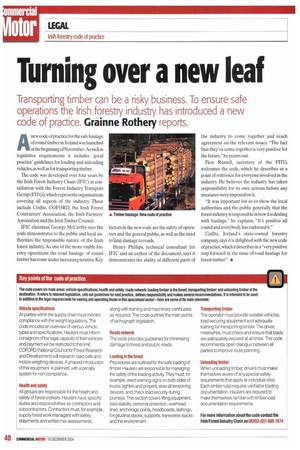Key points 01 the code of practice
Page 40

If you've noticed an error in this article please click here to report it so we can fix it.
The code covers six main areas: vehicle specifications; health and safely; reads network; loading timber in the forest; transporting limber; and unloading timber at the destination. It refers to relevant legislation, sets out guidelines for hest practice, defines responsibility and makes several recommendations. It is intended to be used In addition to the legal requirements for owning and operating trucks in this specialised sector — here are some al its main elements: Vehicle specifications All parties within the supply chain must monitor compliance with the weight regulations. The code includes an overview of various vehicle types and specifications. Hauliers must inform consignors of the legal capacity of their vehicles and payment will be restricted to this limit COFORD (National Council for Forest Research and Development) will research load cells and mobile weighing devices. A phased introduction of this equipment is planned, with a penalty system for non-compliance.
Health and safety All groups are responsible for the health and safety of forest workers. Hauliers have specific duties and responsibilities as contractors and subcontractors. Contractors must, for example, supply forest work managers with safety statements and written risk assessments, along with training and machinery certificates as required. The code outlines the main points of tachograph legislation.
Roads network
The code provides guidelines for minimising damage to forest and public roads.
Loading in the lorest Procedures are outlined for the safe loading of timber. Hauliers are responsible for managing the safety of the loading activity. They must, for example, erect warning signs on both sides of trucks, tighten and properly stow all tensioning devices, and check load security during journeys. This section covers lifting equipment, load stability, personal protection, overhead lines, anchorage points, headboards, lashings, longitudinal stacks, supports, transverse stacks and the environment Transporting timber The operator must provide suitable vehicles, load securing equipment and adequate training for transporting timber. The driver, meanwhile, must check and ensure that loads are adequately secured at all times. The code recommends open dialogue between all parties to improve route planning.
Unloading timber When unloading timber, drivers must make themselves aware of any special safety requirements that apply at individual sites. Each timber load requires verif iable loading documentation. Hauliers are required to make themselves familiar with timber load documentation requirements.


















































































































































































































